Texas
September Astronomy: What's in the North Texas sky this month?

What’s happening in the skies over North Texas this month? September holds some spectacular sights in the night and morning sky. Check out the list below.
THE SUNSET PLANET, VENUS
Venus is visible in the western sky for up to an hour after sunset. On Sept. 4, a waxing crescent moon is less than 5° west of Venus. On Sept. 5, they switch places, now 7° apart with the moon southeast of Venus. The pair is still 5° high 30 minutes after sunset.
By mid-September, Venus remains quite low after sunset. Venus during the last few days of September, stands 7° high in the western sky, 30 minutes after sunset and remains visible for nearly another hour.
Venus’s distance from the Earth varies from 24 million miles to 162 million miles. Mars averages a distance from the Earth of 140 million miles. The closest recorded distance to Mars from Earth was recorded in August 2003 when the two were 34.8 million miles apart. According to NASA, the two will not be that close again until the year 2237.
MORNING PLANETARY DELIGHT
The pre-dawn hours will feature six planets. Keep an eye on Mercury, Mars, Jupiter, Uranus, Neptune and Saturn in the hours before sunrise. The planets always appear lying along the ecliptic, which is the plane of our solar system.
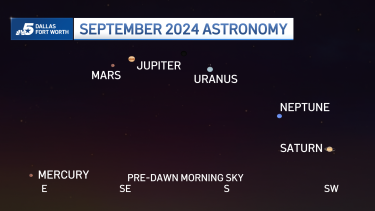
Mercury is 48 million miles away from Earth when they are at their closest. The maximum distance between the two when they are on opposite ends of their orbits is 137 million miles.
Mars averages a distance from the Earth of 140 million miles. The closest recorded distance to Mars from Earth was recorded in August 2003 when the two were 34.8 million miles apart. According to NASA, the two will not be that close again until the year 2237.
Jupiter’s distance from the Earth varies from 336 million miles to 600 million miles.
Saturn’s distance varies from the Earth. When the two are closest, they lie approximately 746 million miles apart, or eight times the distance between the Earth and the Sun.
At their most distant, when they lie on opposite sides of the Sun from one another, they are just over a billion miles apart, or 11 times the distance between the Earth and the Sun.
When Neptune and the Earth line up on the same side of the Sun, at their closest, they are only 2.7 billion miles apart. But when the planets are on opposite sides of the Sun, they can put as many as 2.9 billion miles between them.
FOLLOW THE ZODIACAL LIGHT
During the September pre-dawn, a glow caused by millions of tiny dust particles filling our inner solar system can be observed on clear moonless nights from very dark locations. The zodiacal light is a faint cone-shaped glow. This zodiacal light shines with similar or a bit fainter brilliance than the Milky Way and is located along the ecliptic, which is angled steeply to the horizon this month, improving your chances of seeing it.
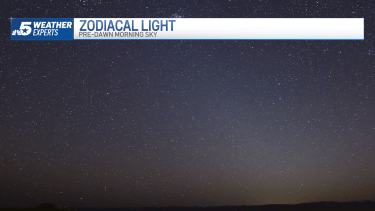
The first two weeks of September are the most favorable time this month to view this phenomenon. Any glow from the urban lights of Dallas-Fort Worth will limit the view.
PEAK OF THE ε-PERSEID METEOR SHOWER
September is not known for its meteor showers. From Sept. 5 through Sept. 2, the ε-Perseids meteor shower runs. Despite their name, these meteors are not caused by the same comet, Swift-Tuttle, as the August Perseids. They simply appear to radiate from the same point in the night sky –which is how meteor showers get their names.

At their maximum, you can look for roughly five ε-Perseids per hour, coming from the general area of the constellation Perseus high in the southwest sky.
The ε-Perseids can be seen from anywhere in the Northern Hemisphere. You are more likely to see them if you have an unobstructed view with clear skies in a very dark place far from any urban light sources.
WHEN DOES THE INTERNATIONAL SPACE STATION FLY OVER NORTH TEXAS?
The International Space Station will make flybys across the North Texas sky this month. The ISS appears as a fast-moving star across the night sky.
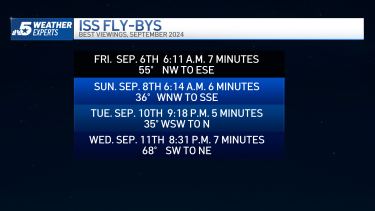
The ISS rotates around the Earth at a speed of 17,500 mph. The ISS rotates about its center of mass at a rate of about four degrees per minute so that it will complete a full rotation once per orbit. This allows it to keep its belly towards the Earth. One revolution around the planet takes about 90 minutes (16 per day).
Also, the ISS sits at an altitude of 250 miles above the Earth. By the way, that is 1.32 million feet. Most commercial airplanes fly between 33,000 to 42,000 feet.
A SEPTEMBER FULL MOON
On Sept. 17, there is a full moon.

This full moon is called the “Corn Moon.” It gets its name after the time of year that corn is harvested.
It is also called the “Harvest Moon.” This is given to the full moon closest to the fall equinox. The reason why the Harvest Moon varies is that the lunar month doesn’t line up with the equinox. Usually, the closest full moon occurs in September, but every three years or so, it falls in October. When the October full moon is not a Harvest Moon, it is known as the Hunter’s Moon.
Other names refer to the “Autumn Moon”, “Child Moon”, “Falling Leaves Moon”, “Yellow Leaf Moon” and “Mating Moon.”
MOON PHASES

Also, check out other phases of the moon this month.
On Sept. 18 at 8:23 a.m. CDT., the moon will be at perigee, it is closest to the Earth for this orbit at 222,007 miles.
On Sept. 5 at 9:53 a.m. CDT., the moon will be at apogee, its farthest from the Earth for this orbit at 252,408 miles.
THE SEPTEMBER EQUINOX
On Sept. 22 the seasons officially change. The September Equinox is also called the Autumnal Equinox in the Northern Hemisphere and the Vernal Equinox in the Southern Hemisphere.
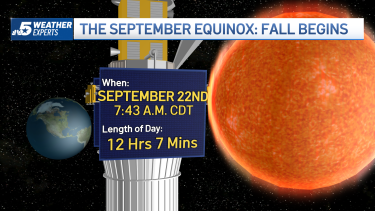
It signals the point where the Earth experiences roughly equal lengths of day and night. Also, this will mark the beginning of fall in the Northern Hemisphere and spring in the Southern Hemisphere.

With the passing of the September Equinox, the Earth has traveled 438 million miles around the Sun. The Earth is moving at an orbital speed of 66,616 mph. This speed is fast enough to cover the planet’s diameter in 7 minutes and the distance to the Moon in 4 hours.
THE TRANSIT OF A JUPITER MOON
Ganymede, Jupiter and the solar system’s largest moon will transit across the planet this month.
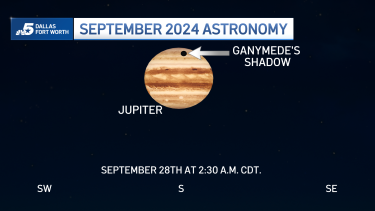
The moon’s huge shadow crosses Jupiter’s polar region from about 1:45 a.m. to 3:40 a.m. CDT. on Sept. 28.
Please enjoy these events happening in the night sky this month. Until then…Texans, keep looking up!

Texas
Texas investigations into Charlie Kirk posts spark free-speech lawsuit

What we know about the return of cancel culture
People sharing critical posts online about Charlie Kirk have faced suspension at work. This is what we know now about cancel culture.
A Texas teachers union has sued the state over what it said was a trampling of educators’ free speech rights when hundreds came under investigation for their comments after the killing of Charlie Kirk.
The Texas branch of the American Federation of Teachers filed the federal lawsuit against the Texas Education Agency and its commissioner Mike Morath on Jan. 6, the union said. The suit claims investigations into at least 350 teachers after Kirk’s death were “unlawful” and that a letter issued by Morath to superintendents around the state targeting “reprehensible and inappropriate content on social media” prompted punishment and retaliation against teachers.
Kirk, 31, was fatally shot on Sept. 10, 2025, while speaking at an event at Utah Valley University in Orem, Utah. The cofounder of Turning Point USA, a conservative youth-focused organization, Kirk was a close ally of President Donald Trump. Shooting suspect Tyler Robinson has been charged with his murder.
After Kirk’s death, a wave of backlash came in response to online posts condemning his views or otherwise criticizing him. Right-leaning public figures and prominent social media accounts called for firings of people whose posts they deemed inappropriate.
Morath’s letter on Sept. 12 directed superintendents to report “inappropriate conduct being shared” to the Texas Education Agency’s Educator Investigations Division, which investigates teachers for allegations of misconduct, the Texas AFT said in its suit, which was reviewed by USA TODAY. The union said teachers were investigated not for speech made in classrooms, but for posts made on their personal, often private social media pages.
“In the months since, the consequences for our members have run the gamut from written reprimands and administrative leave to doxxing and termination from their jobs,” AFT Vice President and Texas Chapter President Zeph Capo said at a news conference.
The Texas Education Agency didn’t immediately respond to a request for comment on Jan. 7.
Lawsuit claims teachers were disciplined for exercising free speech
The lawsuit filed by the Texas AFT claims that teachers in public schools have a constitutionally protected right to free speech, and that their speech in their personal capacity, such as on social media, is protected. The suit claims that teachers’ rights were violated when they were investigated or faced disciplinary action for their posts about Kirk. It also alleges that the policy to report teachers for “inappropriate” content was unfairly vague.
“These teachers were disciplined solely for their speech, without any regard to whether the posts disrupted school operations in any way,” the lawsuit reads.
Teachers whose cases are mentioned in the lawsuit were kept anonymous, Capo said, to protect them from further harassment. Many teachers are fearful to express any more opinions, effectively silencing their speech, he said.
One of the teachers, who made a post described in the lawsuit as one that “simply raised questions about the circumstances of Mr. Kirk’s death and did not promote violence in any way,” was shared by a lawmaker who used it as part of an election campaign and called for the teacher’s dismissal. The high school English teacher, who has taught for 27 years, was placed on administrative leave and later fired. She settled a wrongful termination claim with the school district, the lawsuit said.
Another teacher of 16 years and a military veteran who previously won “Teacher of the Year” in his school district and made posts criticizing Kirk for his views on Black Americans is under an ongoing investigation by the state agency, the lawsuit said.
“We denounced Charlie Kirk’s assassination, we denounced violence after Uvalde. We denounce violence,” said AFT President Randi Weingarten. “What happened in the next few days (after Kirk’s killing), wasn’t about violence or denouncing violence, it was about muzzling the expression of constitutionally protected nonviolent speech.”
Dozens lost jobs over posts about Kirk
In the wake of Kirk’s death in September, USA TODAY counted dozens of examples of people who lost their jobs, were suspended or investigated over posts or comments they made about the conservative podcaster, including educators, lawyers, doctors, first responders and others.
They include a dean at Middle Tennessee State, Laura Sosh-Lightsy, who was fired for a social media post saying she had “zero sympathy” for Kirk; a Marine who called Kirk a “racist man” who was “popped”; and Jimmy Kimmel, whose ABC show was temporarily suspended after he made comments about Kirk.
Some educators who lost their jobs filed lawsuits alleging their free speech rights were violated. A teacher in Iowa who compared Kirk to a Nazi; a South Carolina teacher’s assistant who posted a Kirk quote and said she disagreed with him but called the death a “tragedy”; and an employee of an Indiana university who said Kirk’s death was wrong and condemned some of his beliefs all filed suits on free speech, according to reporting from the USA TODAY Network. Each case kicked up a flurry of social media outrage and calls for the educators’ firings.
In Tennessee, a tenured theater professor at Austin Peay State University was reinstated after originally being fired for comments he made online after Kirk’s killing, the Tennessean, part of the USA TODAY Network, recently reported.
Texas
Horror of school attack in Uvalde, Texas, brings tears as officer faces trial over police response – WTOP News

CORPUS CHRISTI, Texas (AP) — Families whose loved ones died in the Uvalde, Texas, elementary school massacre sobbed in court…
CORPUS CHRISTI, Texas (AP) — Families whose loved ones died in the Uvalde, Texas, elementary school massacre sobbed in court while listening to frantic 911 calls during the first day of testimony in the trial of a police officer accused of failing to protect the children by not doing enough to stop the attack.
A prosecutor told jurors Tuesday that former school officer Adrian Gonzales arrived outside the school just before the teenage gunman went inside but didn’t make a move to stop him even when a teacher pointed to where he was firing in a parking lot.
The officer went into Robb Elementary only “after the damage had been done,” special prosecutor Bill Turner said during opening statements.
The judge overseeing the case and attorneys warned jurors that the testimony and images will be emotional and difficult to process. Among those expected to testify will be some of the victims’ families.
Tissue boxes were brought to the families as the testimony began. Some shook their heads as they listened to audio from the first calls for help. Their cries grew louder as the horror unfolded on the recordings.
Defense attorneys disputed that Gonzales — one of two officers charged in the 2022 attack — did nothing, saying he radioed for more help and evacuated children as other police arrived.
“The government makes it want to seem like he just sat there,” said defense attorney Nico LaHood. “He did what he could, with what he knew at the time.”
Prosecutors focused sharply on Gonzales’ steps in the minutes after the shooting began and as the first officers arrived. They did not address the hundreds of other local, state and federal officers who arrived and waited more than an hour to confront the gunman, who was eventually killed by a tactical team of officers.
Gonzales has pleaded not guilty to child abandonment or endangerment and could be sentenced to a maximum of two years in prison if convicted.
Witness testimony will resume Thursday morning.
Students grabbed scissors to confront attacker
Defense attorneys said Tuesday that Gonzales was focused on assessing where the gunman was while also thinking he was being fired on without protection against a high-powered rifle.
“This isn’t a man waiting around. This isn’t a man failing to act,” defense attorney Jason Goss said.
Gonzales and former Uvalde schools Police Chief Pete Arredondo are the only two officers to face criminal charges over the response. Arredondo’s trial has not been scheduled.
Gonzales, a 10-year veteran of the police force, had extensive active shooter training, the special prosecutor said.
“When a child calls 911, we have a right to expect a response,” Turner said, his voice trembling with emotion.
As Gonzales waited outside, children and teachers hid inside darkened classrooms and grabbed scissors “to confront a gunman,” Turner said. “They did as they had been trained.”
Families question why more officers weren’t charged
It’s rare for an officer to be criminally charged with not doing more to save lives.
“He could have stopped him, but he didn’t want to be the target,” said Velma Lisa Duran, sister of teacher Irma Garcia, who was among the 19 students and two teachers who were killed.
Some families of the victims have voiced anger that more officers were not charged given that nearly 400 federal, state and local officers converged on the school soon after the attack.
An investigation found 77 minutes passed from the time authorities arrived until they breached the classroom and killed Salvador Ramos, who was obsessed with violence and notoriety leading up to the shooting.
Reviews found many failures with police response
State and federal reviews of the shooting cited cascading problems in law enforcement training, communication, leadership and technology, and questioned why officers waited so long.
The officer’s attorneys told jurors that there was plenty of blame to go around — from the lack of security at the school to police policy — and that prosecutors will try to play on their emotions by showing photos from the scene.
“What the prosecution wants you to do is get mad at Adrian. They are going to try to play on your emotions,” Goss said.
“The monster who hurt these children is dead,” he said.
Prosecutors likely will face a high bar to win a conviction. A Florida sheriff’s deputy was acquitted by a jury after being charged with failing to confront the shooter in the Parkland, Florida, school massacre in 2018 — the first such prosecution in the U.S. for an on-campus shooting.
___
Vertuno reported from Austin, Texas. Associated Press journalists Nicholas Ingram in Corpus Christi, Texas; Juan A. Lozano in Houston; and John Seewer in Toledo, Ohio, contributed.
Copyright
© 2026 The Associated Press. All rights reserved. This material may not be published, broadcast, written or redistributed.
Texas
Former Texas Longhorns Fan Favorite WR Commits to Oklahoma

Former Texas Longhorns fan favorite wide receiver Parker Livingstone committed to the Oklahoma Sooners on Tuesday, per ESPN’s Pete Thamel.
Livingstone, who is transferring after his redshirt freshman season and will have three years of eligibility remaining, took visits to both Indiana and Oklahoma. He will now call Norman home and face his former school and new arch-rival annually in the Red River Rivalry.
The Lucas, Texas, native caught 29 passes for 516 yards and six touchdowns this season. He ranked third in yards, fourth in catches, and second in touchdowns amongst all Longhorns pass-catchers in 2025.
Livingstone’s goodbye message and transfer commitment
Livingstone, who grew up a Longhorns fan, became a fan favorite early on in the season, as he scored three touchdowns in Texas’ opening two games to lead the pass-catching corps. The known fact that he was quarterback Arch Manning’s roommate also contributed to the fan-favorite sentiment. To many, it likely seemed that Livingstone would be here to stay in Austin.
But in college football’s present landscape, there are no guarantees, and Livingstone announced his decision to enter the portal on Jan. 1. His commitment to Texas’ biggest rival now adds to the shock of his departure.
“Never in a million years did I think I would be going into the portal looking for a new home,” Livingstone wrote in his goodbye on X. “Some things are out of my control. Such is the reality of the ever-changing landscape of college football. Emptied my tank every day for this great university, my teammates & all of the good folks of Texas. Grateful.”
The message that Livingstone’s transfer portal decision was “out of (his) control” brought a whirlwind of speculation and interest in the details of his exit from the Texas Longhorns program. It’s difficult to put together exactly what occurred behind closed doors to shatter the Livingstone-Texas relationship. But after an article in The Athletic mentioned Livingstone’s “out of my control” wording in his note, On Texas Football’s Bobby Burton wrote on X:
“Livingstone was offered a mid-six-figure NIL/rev share deal and turned it down. The offer was never withdrawn. But yeah, he was forced out involuntarily. Whatever.”
Livingstone’s move from one side of the Red River to the other will certainly be a storyline heading into the 2026 edition of the rivalry matchup on Oct. 10.
With both Livingstone and DeAndre Moore Jr. exiting the Forty Acres to enter the transfer portal recently, Texas has been expected to pursue top portal names to add to its wide receiver room. One of those players is former Auburn wide receiver Cam Coleman, who has taken a visit to Austin and is still in his decision-making process. Coleman, who will likely be a one-and-done at his next collegiate destination due to his NFL Draft status, ranks as the No. 1 player in the On3 Transfer Portal Rankings.
-

 World1 week ago
World1 week agoHamas builds new terror regime in Gaza, recruiting teens amid problematic election
-

 News1 week ago
News1 week agoFor those who help the poor, 2025 goes down as a year of chaos
-

 Science1 week ago
Science1 week agoWe Asked for Environmental Fixes in Your State. You Sent In Thousands.
-

 Business1 week ago
Business1 week agoA tale of two Ralphs — Lauren and the supermarket — shows the reality of a K-shaped economy
-

 Detroit, MI4 days ago
Detroit, MI4 days ago2 hospitalized after shooting on Lodge Freeway in Detroit
-

 Politics1 week ago
Politics1 week agoCommentary: America tried something new in 2025. It’s not going well
-

 Politics1 week ago
Politics1 week agoMarjorie Taylor Greene criticizes Trump’s meetings with Zelenskyy, Netanyahu: ‘Can we just do America?’
-

 Health1 week ago
Health1 week agoRecord-breaking flu numbers reported in New York state, sparking warnings from officials

















